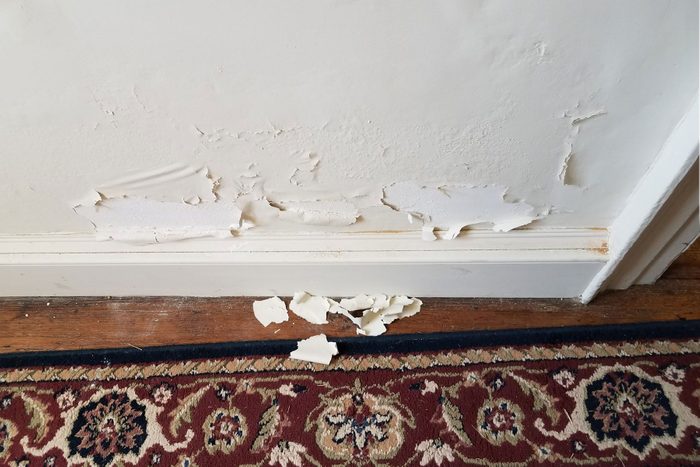How To Fix Peeling Paint
Updated: Mar. 07, 2024

Discover common causes of peeling paint and effective strategies to fix it.
There’s nothing quite as satisfying as standing back and admiring a newly finished paint job. What’s less satisfying is if that same paint job begins to bubble and peel just a few months later. I’ve been called in to fix mysterious paint peeling issues for customers who just can’t understand where they went wrong.
Here to help explain ways to avoid peeling paint and how to fix it when it happens are two industry pros, Rachel Otto from Fleury Lumber and Joseph Umana from Painting Belen.
On This Page
About the Experts
Rachel Otto is a Benjamin Moore paint specialist at Fleury Lumber in Easthampton, Massachusetts.
Joseph Umana is the owner of Painting Belen, a residential painting company in Western Massachusetts. Joseph is a licensed Home Improvement Contractor in the State of Massachusetts with nine years experience in the painting industry.
What Causes Peeling Paint?
Peeling paint is rarely caused by bad paint. “It’s usually bad prep work,” Umana says, but there are some other reasons why your paint might be peeling.
Moisture issues
Moisture from rain and snow, poor attic ventilation, overflowing gutters or even misdirected sprinklers can cause peeling paint on your home’s exterior. Water infiltrates the wood, causing the fibers to swell and stretch the paint film until it cracks. After it cracks the water continues to seep through, saturating the wood and breaking the paint bond— ultimately resulting in peeling paint.
Window sills, soffits and wood joints are particularly prone to this issue. Inside the home, the same thing can happen when water from plumbing leaks, leaky roofs or poor bathroom ventilation seeps into walls, ceilings and wood trim.
Bad paint conditions
Applying paint outside the manufacturer’s recommended application temperatures and conditions can lead to peeling paint.
“If it’s too cold, the liquids in the paint freeze before it has a chance to cure,” Otto says, “As it tries to dry, the paint will crack or peel.”
Painting in high temperatures or direct sun is just as bad. “You can get the same bubbling, cracking and peeling,” Otto says.
Painting wood that is not completely dry is also problematic. Otto explains that as moisture attempts to escape from wood during drying, it can push paint away from the surface, causing bubbling and peeling.
It’s also best to avoid painting outside if heavy rainfall is expected in the next 24 hours.
Not following dry times
It is especially important to follow manufacturer dry times before recoating to avoid peeling paint. Paint sometimes feels dry to the touch before it has hardened, but a second coat applied too soon can soften the first and create a weaker bond.
“If the paint can says to leave two hours between coats, wait the two hours,” Otto says.
Poor surface prep
Umana points to bad prep work as the main culprit for peeling paint. “You have to take the time to scrape, sand and clean really well,” he says, “You’ll regret it if you don’t.” Dirt, mildew and loose paint cause poor paint adhesion and must be removed before painting.
Make sure to use a primer as well, which is formulated to adhere to bare wood and other materials. Umana recommends using an oil primer for most exterior surfaces. “It forms a strong surface bond and is really durable,” he says.
Incompatible paint layers
Applying paint over another paint that is not compatible can cause layer separating and peeling. Putting oil or alkyd paint over latex paint is a common example of this phenomenon.
Oil paint is brittle when dry and cracks and peels when painted over flexible latex paint.
Time and exposure
All paint fails eventually. Exposure to the elements causes paint to dry out over time, crack and let in moisture that breaks the paint’s surface bond with the substrate.
How to Fix Peeling Paint
To prevent peeling paint from happening again, resolve any moisture issues, paint in good weather conditions, thoroughly prep and make sure paint layers are compatible. “Before painting over water damage, make sure the leak is fixed first,” Otto says. Follow these steps to fix peeling paint.
Scrape and sand peeling paint
Use a paint scraper to remove any loose paint. Wear a dust mask and use drop cloths to catch paint chips and dust. Be thorough and work methodically to remove all loose paint.
Use 100 grit sandpaper to smooth any scraped areas and remove any remaining loose paint. Sand down the edges of scraped areas to smooth the transition from paint to bare wood.
Caution: Houses constructed before 1978 may harbor lead-based paint. Scraping and sanding this paint can generate hazardous lead dust that can pose serious health risks. For more information visit the Environmental Protection Agency’s (EPA) lead safety website.
Clean and let dry
Use a damp cloth to wipe away any accumulated dust. Let the area dry before proceeding. For exterior work, Umana uses a leaf blower to quickly remove dust from large areas.
Prime
Wear gloves and apply primer to any areas of bare wood before painting. “It may take longer, but it makes the paint last longer,” Umana says, “It’s worth it.” He also recommends against using self-priming products, especially on exterior bare wood. “The bond is not as good,” he says.
For interior peeling paint, Otto suggests using a bonding primer to improve adhesion with drywall surfaces.
Paint
After waiting the primer manufacturer’s recommended dry time, apply two coats of paint to the prepared surface. Wear gloves and allow proper dry times between coats.
FAQ’s
Is it OK to paint over peeling paint?
No.
Painting over peeling paint is a waste of time and money unless you scrape, sand and prime first.
Does peeling paint mean water damage/mold?
It can.
“Peeling paint can be an indicator of moisture issues and potentially, mold,” Otto says, “It is something to look for.”
